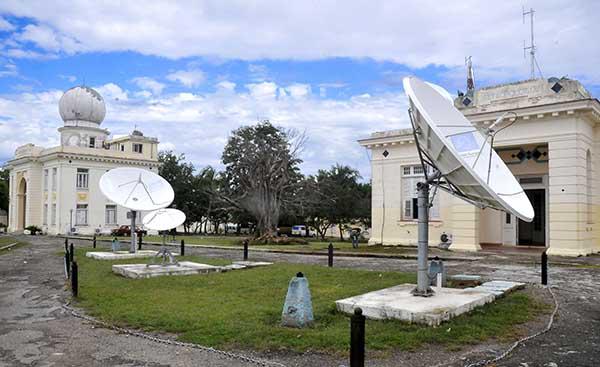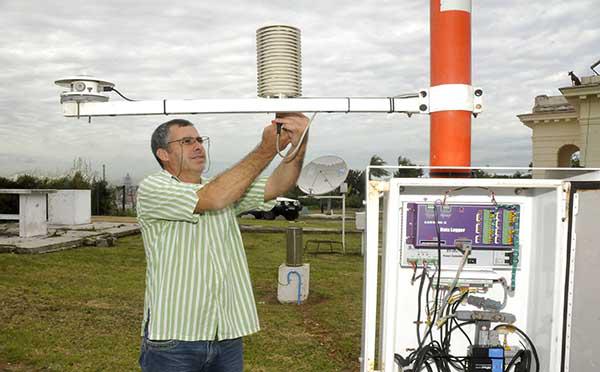
The Cuban Institute of Meteorology (INSMET) has a decisive impact on the socioeconomic development of the country, as it provides authoritative, reliable and accurate weather and climate information, based on an early warning system, which prevents the loss of human lives and mitigates damages caused by natural disasters.
Attached to the Environment Agency and founded on October 12, 1965, INSMET is located on the town of Casablanca’s hill, bordering the Bay of Havana, where in 1908 the National Observatory was located.
This scientific institution is responsible for weather forecasts, monitoring air pollution, and studying solar radiation, extremely dry seasons and heavy rains and storms, especially the hurricanes that often affect the Caribbean.
The Institute has 68 weather stations which record and verify data, and a network of eight radars (three from Japan, four from the Soviet Union and one German), all of which are fully automated and working at full capacity, thanks to the ingenuity of Cuban specialists.
This national system allows for observations in each of the territories of the island to be transmitted to the headquarters in Casablanca and provincial centers with immediacy and accuracy, providing the necessary information to make short and medium term forecasts.
The main area of INSMET’s work is dedicated to research and services; the institute is responsible for measuring, collecting and processing climate and air pollution variables; operating surveillance systems; and carrying out scientific investigations aimed at improving weather and climate forecasting, especially of phenomena that constitute a danger to human life, threaten material resources and the national economy.

The purely investigative sphere brings together four national centers, dedicated to climate, agrometeorology, atmospheric physics and air pollution, while that of services includes basic systems, which cover the areas of forecasts, maritime meteorology, the weather station network, infocommunications and radars.
The latter department, headed by the Master in Advanced Technology, Magdiel Carrasco Díaz, is responsible for issuing different forecasts and special services for the agricultural, marine and aerospace sectors, among others.
An example of the use of such data is the case of the Ministry of the Interior, which, when investigating traffic accidents, requests the necessary information to measure the impact of weather conditions on the occurrence. The television and film industry also has similar requirements when determining the optimal conditions for filming.
Carrasco Díaz added that the Mariel Special Development Zone has requested a commercial service related to the forecasting of maritime conditions at its port for the loading and unloading of goods. “In addition, we deal with the calibration of meteorological instruments, primarily those that record the temperature, pressure and humidity of the atmosphere,” he noted.
In order to offer these varied services, the institution has established agreements with the World Meteorological Organization (WMO) and other similar institutions that provide advice, information and technology exchange. “We have strong links with the Regional Hurricane Center, located in the United States,” the specialist added.
U.S. experts have repeatedly visited INSMET and participated in scientific events on the island, while Cuban specialists have received training courses at the National Hurricane Center (NHC) in Miami, as well as participating in congresses in the U.S.
However, the U.S. economic, commercial and financial blockade against the island, in force for over 50 years, prevents the acquisition of parts and equipment in the U.S. market for the modernization of Cuban weather stations, as well as access to the latest technology to receive satellite images.
In this regard, Carrasco Díaz noted the support of the United Nations Educational, Scientific and Cultural Organization (UNESCO), together with agreements signed with Panama, Norway, China and Russia. “To the same extend, we provide collaboration in Haiti, with the installation there of an automated weather station, and in Equatorial Guinea to strengthen its weather system.”
For the scientist, it is satisfying to recall the visits of Comandante Fidel Castro to INSMET, during moments when extreme weather events such as hurricanes affected the island. “I worked closely with him more than four times. He personally dealt with everything, even the conditions of the workforce. He left us with a positive energy. In that critical stage we worked 24 hours a day, but on hearing of the presence of Fidel, our fatigue disappeared. His hand on our shoulders and accurate questioning energized us.”
Dr. Lourdes Álvarez Escudero, professor and senior research fellow, told Granma International of the training she has undertaken in Mexico, Ecuador and Norway. She has participated in joint projects with Canada, Brazil and China, while also working with Venezuela in the field of artificial rainfall.
She considers herself a product of INSMET, as her father, a physicist, worked at the institution in the 1970s until his retirement, and she became familiar with the field at a young age. She was motivated to study a degree in physics, her thesis for which was based in meteorology, and has since spent her working life at the institution.
“I work as a researcher at the National Center for Atmospheric Physics and studied the climatology of weather events such as storms and mists.” One of her scientific achievements was the development of a map of the annual average of stormy weather events, which is widely used for protection against lightning.
Her husband, physicist Israel Borrego Montejo, has witnessed the technological changes implemented with a view to modernizing and advancing INSMET. He recalled working with one of the first Soviet computers to arrive in the country for data processing, which was huge and had a very low memory capacity.
“Around 1985, the first desktop PCs arrived to the Institute. In 1987, an internal network was installed for exchanges between machines. This also allowed us to save information before deactivating the Soviet computer. Then, in the 90s we began the digitization and automation of the processes,” explained Israel, who has been working at INSMET since 1983.
Engineer Orlando Osa Peralo operates the island’s automatic weather stations. He has the great responsibility, along with two other experts, of taking data from different digital instruments that measure pressure, humidity, temperature and other parameters in order to develop a histogram with average, minimum and maximum values over a period of up to 10 minutes, every three hours.
The use of automated technology has been key to ensuring the accuracy and immediacy of information, thus responding to the requirements of the WMO. “We are at about the same level as developed countries. We do not have the same resources, but we do have the scientific talent to solve many problems,” he stressed.
Maibys Lorenzo Sierra, at the National Center for Atmospheric Physics, is working to develop a system that permits the numerical forecasting of local and small-scale phenomena such as storms.
The young scientist feels professionally fulfilled within the Institute. Her work requires her to apply science, conduct research, receive further training and teach at the University of Havana. “My studies are a priority. Since I began in 2008 I have had the opportunity to train in India and Brazil.
“I finished my masters (in mathematical sciences) in 2011 and began my doctorate in 2013. I have to present my thesis in July. I am already preparing for a post doctorate,” she explained, noting that she sees a strong future here.
On its 50th anniversary, INSMET workers received a congratulatory message from President Raúl Castro, in which he stated: “Continue moving forward, before current and future climatic challenges, committed and always alert.”















